So You Want To Be a Glamour Camper?

Definitely NOT me. But my long-term tent is like this, as in it’s the same size. This is Judy, the glamour camping Queen. But I did take the pic. She gives me something to strive for. Or not.
As a long-time camper I’ve morphed over the years from a pup tent with a ¼ inch mat to cushion my body against the ground to a more luxurious camping experience. Once or twice a year the one-man tent and the mat still come out for a backpacking foray to fish for wild trout in backcountry streams, albeit the mat has grown to a ¾ inch thick cushion. Once a year for a 10-12 day stay my husband and I pull out all the stops and glamour camp “glamp” in a remote part of Wyoming. All the other times which approximate ten to fifteen 2-3 night stays, fall somewhere in between on the comfort scale.
The single piece of equipment that sets apart the long glamping trip from all the other camp-outs, is the tent. For the Wyoming annual outing we purchased a 10 ft. x 18 ft. tent, large enough to enter from either end standing upright all the way through. We dubbed it the B.A.T. as in Big Ass Tent. The initial cost was $300. We’ve used it 4 times, which breaks down into a lodging cost of about $8 per night ($300 / 40 nights). The effort expended to set it up precludes using it for shorter trips.
Before we get to the good part, here are other camping related posts you might like:
Now back to the good part. Assuming you want to pursue camping outings in the range of say 2-5 nights, you don’t want to do the crawl around on your hands and knees routine, and you’re starting from ground zero or your equipment is outdated, here’s a list of basic items I recommend you consider. Since a good night’s sleep is so critical, this article will cover the basics for that. In my opinion once you have that down, everything else is a piece of cake. And short of that if you’ve got plenty of rest, you can handle the other potential mishaps that are inherent to interaction with the great outdoors.
- A tent in the range of 9 ft. x 12 ft. with a large “D” opening on the side (not end) will provide a moderate amount of space and be quick to set up. You’ll want to ensure there’s a gear loft and gear pockets in it for storage. Tents have come a long way in the ease to set-up department. Color codings on the tent poles, amenities such as gear lofts and pockets, and various ventilation extras will surprise you if you’ve not seen a new tent in the last 5 years. A new tent purchase comes with everything you need to set it up (rain fly, stakes, instructions, poles, guy wires, etc.), with the exception of a ground cloth. However, I recommend purchasing a separate set of heavy-duty tent stakes in lieu of those that are included. You’ll need to purchase a ground cloth, which does NOT come with the tent. The ground cloth should be a heavy duty plastic tarp, about the same size as the footprint of the tent (bigger is better here because you can tuck under the excess – too small and you’ll still have a wet tent floor which is what you’re attempting to prevent). This is laid on the ground first; erecting the tent over it and then tucking any visible ground cloth in under the tent once the tent is completely staked (do not stake the ground cloth to the tent!). The ground cloth is critical to keeping the floor of the tent dry in rainy weather, or even heavy dew. If the tarp is larger than the tent and you leave the ground cloth showing it’ll gather water which will seep in between the floor of the tent and the ground cloth, and you’ll have a wet floor. Misery will be the result. A rain fly keeps the top dry, a ground cloth the bottom. Both are critical.
- A hammer for pounding in stakes should be thrown permanently into the tent bag.
- Bedding has also come a LONG way. Several years ago we began searching for a way to get the bed off the floor of the tent and discovered they now make frames that stand about the same height from the floor as a normal bed. The frame we purchased from Cabela’s has a pocket into which you insert an inflatable mattress so you never have to worry about sliding off the frame. Tip: partially inflate the mattress then insert into the pocket before topping it off. We purchased a Queen size Coleman inflatable mattress and the Queen sized stand and now camp with a bed that sleeps almost as well as any bed you could hope for. Another wonderful advantage of the frame is the storage underneath. We shove tons of stuff that won’t be needed until the tear-down under the bed and out of sight. The frame folds neatly into its own container for storage.
The 9×12 tent I spoke of previously holds a Queen sized bed with plenty of walk around room.
Tip: inflatable mattresses expand and contract with temperatures. To keep the bed comfortable, take the time to add some air at the end of a cool day. But be careful! If the temperature swings are broad, overfilling can potentially result in a busted seam during the days rising temps.
- Look for a mattress that comes with a BATTERY powered inflating unit (Coleman includes these with their beds) since there won’t be an electrical outlet in your tent! Purchase plenty of appropriate batteries for the unit. DON’T FORGET THE BATTERIES.
Perform a test run of setting up the bed/frame/mattress at home just to make sure everything works.
- Since we sleep on a Queen sized bed at home, sheets are not a factor. I’ll grab a set of my nicest sheets (cotton, not flannel — unless you plan to sleep in the raw, flannel works like Velcro and every turn will be work) and the appropriate blankets from the closet just prior to a trip. Take more blankets than you think you’ll need. Even though you’ll be in a tent, 3-season tents typically mean part of the “ceiling” is mesh. The rain fly will keep you dry, but you’re sleeping in the great outdoors. You can always remove cover but if you don’t bring it, you can’t add it. Note: A down blanket is great for camping; light weight and lots of loft and warmth = sweet dreams.
- An inflatable mattress repair kit should be thrown permanently into the bed container.
- I sleep with my head elevated so I bring pillows from home.
- A small LED headlamp is indispensible in camp and I wear one around my neck during the day so that at nightfall I’m not searching for it. And since we’re talking about sleeping comfort, that sweet little headlamp means you can read in bed for a bit before drifting off to the sound of crickets or frogs or owls or nightingales or loons or all of the above.
Oh yes, KIDS! Assuming they’re old enough for a separate tent (and I have been with all the above recommendations for you), a basic tent with army cots and blankets (again this means you have some storage space beneath the cot) or sleeping bags/pad will have them thinking they’re in heaven. Hang a small headlamp around their neck, put some flashlights in their tent, and nighttime entertainment will never be an issue.
Come back next week and I’ll cover basic equipment for the rest of the camp site and additional tips to make camp-outs something you’ll daydream about.





 About SRT... I’m a traveler, writer and photographer for whom the open road frequently summons. Adventurous solo road trips are a staple for me, and a curiosity. So I created this website to share them and inspire you to step out and give them a try. Welcome!
About SRT... I’m a traveler, writer and photographer for whom the open road frequently summons. Adventurous solo road trips are a staple for me, and a curiosity. So I created this website to share them and inspire you to step out and give them a try. Welcome! 
